Rauschenberg: China/America Mix
On this page you will find articles about Rauschenberg: China/America Mix, which will be on display in the Bob Rauschenberg Gallery from October 22 through December 17, 2014.
* * * * * * * * * * * * * * * * * * * * * * * * * * * * * * * *
Extended, ‘China/America Mix’ exhibit to reopen January 2 and run through January 24, 2015 (12-12-14)
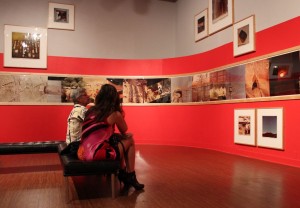 The Bob Rauschenberg Gallery has announced the extension of BOB RAUSCHENBERG: China/America Mix. Originally scheduled to close December 17, the exhibition will reopen by popular demand on January 2 and run through January 24 under the name BOB RAUSCHENBERG: China/America (Re)Mix(ed). (The Bob Rauschenberg Gallery and administrative offices are closed from December 18 through January 1, as is the entire FSW campus.)
The Bob Rauschenberg Gallery has announced the extension of BOB RAUSCHENBERG: China/America Mix. Originally scheduled to close December 17, the exhibition will reopen by popular demand on January 2 and run through January 24 under the name BOB RAUSCHENBERG: China/America (Re)Mix(ed). (The Bob Rauschenberg Gallery and administrative offices are closed from December 18 through January 1, as is the entire FSW campus.)
For more information about the exhibition, please continuing reading
_____________________________________________________________________
Rauschenberg’s influence on Chinese art nearly snuffed by government crackdown following Tiananmen Square demonstrations (11-07-14)
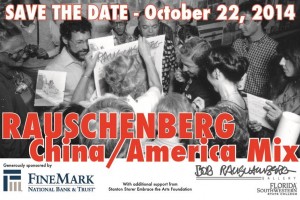 According to Bob Rauschenberg Gallery Director Jade Dellinger, Chinese artists to this day speak in terms of art “before and after Robert Rauschenberg.” But the immediate, short-term impact of his 1985 R.O.C.I. exhibition at the National Art Gallery in Beijing was very nearly snuffed by the government crackdown and cultural repression that followed the demonstrations in
According to Bob Rauschenberg Gallery Director Jade Dellinger, Chinese artists to this day speak in terms of art “before and after Robert Rauschenberg.” But the immediate, short-term impact of his 1985 R.O.C.I. exhibition at the National Art Gallery in Beijing was very nearly snuffed by the government crackdown and cultural repression that followed the demonstrations in 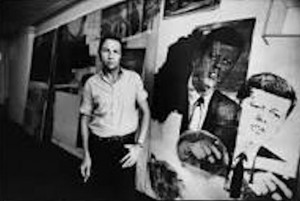 Tiananmen Square that ended in bloodshed on June 4, 1989.
Tiananmen Square that ended in bloodshed on June 4, 1989.
At the time of Rauschenberg’s visit in 1982, pockets of avant-garde artists were practicing experimental art throughout China. In a culture which valued the collective good over the happiness and welfare of its individual citizens, the 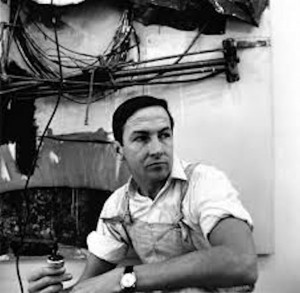 personal expression implicit in and underlying modernism was anathema. Not surprisingly, Chinese experimental artists experienced pushback from the government, which regarded their efforts as “spiritually corrupting” in much the same way as Adolf Hitler and the Nazis sought to purge “degenerate art” from ante bellum Germany 50 years before.
personal expression implicit in and underlying modernism was anathema. Not surprisingly, Chinese experimental artists experienced pushback from the government, which regarded their efforts as “spiritually corrupting” in much the same way as Adolf Hitler and the Nazis sought to purge “degenerate art” from ante bellum Germany 50 years before.
Among the 70,000 people who flocked to the National Art Gallery to see R.O.C.I. in its first week and the 300,000 who saw the show before it 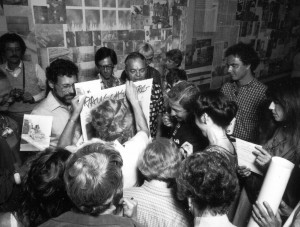 closed six weeks later were undoubtedly many of the artists who were participating in the avant-garde movement. “[N]ot only did Rauschenberg’s actual presence prove that they were not forgotten by the outside world, it signaled that there was more than a glimmer of possibility that those other, powerful modern countries were also interested in them and their art,” writes Georgetown masters candidate Tidings Chan.
closed six weeks later were undoubtedly many of the artists who were participating in the avant-garde movement. “[N]ot only did Rauschenberg’s actual presence prove that they were not forgotten by the outside world, it signaled that there was more than a glimmer of possibility that those other, powerful modern countries were also interested in them and their art,” writes Georgetown masters candidate Tidings Chan.
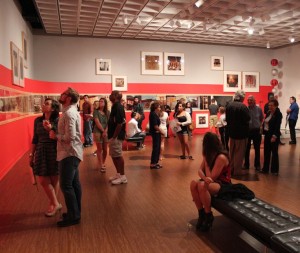 Bolstered by this perceived validation, this new wave of Chinese artists continued to explore ways to change and depart from the staid and stale means of traditional artistic media, motif and expression, just as Rauschenberg had hoped they would. “R.O.C.I. was taking images of these countries solely through [Bob’s] eyes and bringing it back to them so that they could see things in a different light,” explains Donald Saff, who not only accompanied Rauschenberg to China in 1982, but
Bolstered by this perceived validation, this new wave of Chinese artists continued to explore ways to change and depart from the staid and stale means of traditional artistic media, motif and expression, just as Rauschenberg had hoped they would. “R.O.C.I. was taking images of these countries solely through [Bob’s] eyes and bringing it back to them so that they could see things in a different light,” explains Donald Saff, who not only accompanied Rauschenberg to China in 1982, but 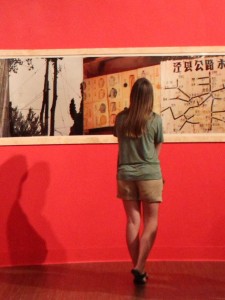 subsequently served as R.O.C.I.’s artistic director. “To give them license to go beyond the template of their own approach to their art – to the historically-mired approach that many of the artists in these countries had because of a lack of seeing alternatives.”
subsequently served as R.O.C.I.’s artistic director. “To give them license to go beyond the template of their own approach to their art – to the historically-mired approach that many of the artists in these countries had because of a lack of seeing alternatives.”
“Although inspired by new ideas from the West,” adds Chinese art critic Fei Dawei, “Chinese artists in the 1980s had begun to write their own story, and this was the real beginning of Chinese contemporary art.” So empowered, artists like Xu Bing, Wu Shan Zhuan, Huang Yong Ping, Gu Wenda and Yang Zhigun staged an exhibition at the National Art Gallery in 1989 of avant-garde works created between 1985 and 1987. Called China/Avant-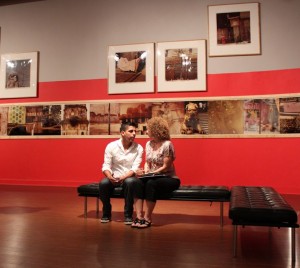 Garde, the logo for the socially-critical, highly incendiary show was a giant “No U-Turn” traffic sign signal emblazoned on the black carpet leading from the street into the exhibition hall. True enough, there was no turning back now for the Chinese experimental artists.
Garde, the logo for the socially-critical, highly incendiary show was a giant “No U-Turn” traffic sign signal emblazoned on the black carpet leading from the street into the exhibition hall. True enough, there was no turning back now for the Chinese experimental artists.
China/Avant-Garde included 297 paintings, sculptures, videos and installations produced by 186 artists. Every province in China was represented. “Some of these works were influenced 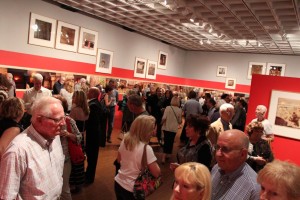 by and critical of such Western modes as Dada, Surrealism and Pop, while others sought inspiration by looking backwards to ancient Chinese forms of expression rooted in Taoist philosophy and mysticism,” Tidings Chan observes. Some of the works were outrageously scurrilous, such as a flesh-colored inflatable object with obvious sexual connotations, flanked by
by and critical of such Western modes as Dada, Surrealism and Pop, while others sought inspiration by looking backwards to ancient Chinese forms of expression rooted in Taoist philosophy and mysticism,” Tidings Chan observes. Some of the works were outrageously scurrilous, such as a flesh-colored inflatable object with obvious sexual connotations, flanked by 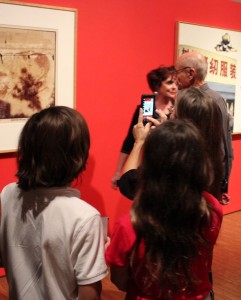 blown up condoms and surgical gloves. “Receiving the most attention were three portraits of Chairman Mao with pane patterns on the paintings by Wang Guangyi.”
blown up condoms and surgical gloves. “Receiving the most attention were three portraits of Chairman Mao with pane patterns on the paintings by Wang Guangyi.”
Artists excluded from the exhibition set up in the street outside the exhibition hall. One artist borrowed 100 times his monthly salary just so he could be part of the happening. Seeing that it was losing its vice grip on Chinese art (which for centuries had been employed solely to express moral themes and political propaganda), the government was quick to close the exhibition when two performance artists fired gunshots at their own installation, a piece called Dialogue that consisted of two telephone boxes with a mirrored panel in between.
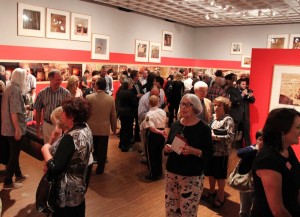 Although China/Avant-Garde was later re-opened, the government permanently shut the exhibition down after bomb threats were purportedly received by the National Art Gallery, the local city government and the Beijing Security Bureau. Three months later, many of China/Avant-Garde’s organizers and artists participated in pro-democracy demonstrations in
Although China/Avant-Garde was later re-opened, the government permanently shut the exhibition down after bomb threats were purportedly received by the National Art Gallery, the local city government and the Beijing Security Bureau. Three months later, many of China/Avant-Garde’s organizers and artists participated in pro-democracy demonstrations in 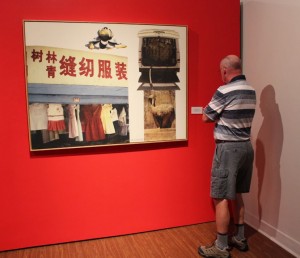 Tiananmen Square. Some were arrested and incarcerated. The rest were driven underground.
Tiananmen Square. Some were arrested and incarcerated. The rest were driven underground.
But as the exhibition’s logo attested, there really was no turning back for Chinese artists or art, and as Jade Dellinger now notes, Bob Rauschenberg’s 1985 R.O.C.I. show demarks a sharp dividing line between traditional and contemporary Chinese art.
You can see examples of the art that sparked these changes in RAUSCHENBERG: China/America 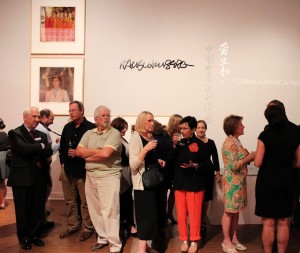 Mix at the Bob Rauschenberg Gallery on the Lee campus of Florida SouthWestern State College now through December 17. The show includes selections from Seven Characters (seven suites of 74 works, each containing silk, ribbon, paper pulp relief and gold on handmade Xuan paper that is embedded with collages of Rauschenberg imagery and Chinese characters) and Chinese Summerhall, the famous 100-foot-long collaged color photograph that Rauschenberg created at GraphicStudio at USF in Tampa following his return in 1982 from Jingxian, China.
Mix at the Bob Rauschenberg Gallery on the Lee campus of Florida SouthWestern State College now through December 17. The show includes selections from Seven Characters (seven suites of 74 works, each containing silk, ribbon, paper pulp relief and gold on handmade Xuan paper that is embedded with collages of Rauschenberg imagery and Chinese characters) and Chinese Summerhall, the famous 100-foot-long collaged color photograph that Rauschenberg created at GraphicStudio at USF in Tampa following his return in 1982 from Jingxian, China.
For more information or gallery days, times and hours, please telephone 239-489-9313 or visit http://RauschenbergGallery.com
_______________________________________________________________________
Fully committed, Bob Rauschenberg leveraged entire estate to finance R.O.C.I. (10-30-14)
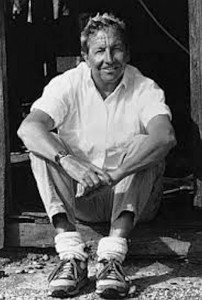 Imagine the cost of travelling for a two or three weeks to Mexico. And then to China, Tibet, Malaysia, Cuba, Chile, Venezuala, East Germany and Russia. Now add in the expense of sending an advance team ahead to scout out hotels, restaurants and places to visit and see. Of course, you’d need to bring along an entourage of family and friends. And if you’re an artist, you’d want to bring along art supplies and materials as well. Starting to feel financially overwhelmed? Well that’s undoubtedly how Bob Rauschenberg felt as he left for Tobago in 1985 to figure out how he was going to pay for the Rauschenberg Overseas Cultural Interchange global tour to promote peace and understanding through the language of art that he’d just announced to the world at the United Nations.
Imagine the cost of travelling for a two or three weeks to Mexico. And then to China, Tibet, Malaysia, Cuba, Chile, Venezuala, East Germany and Russia. Now add in the expense of sending an advance team ahead to scout out hotels, restaurants and places to visit and see. Of course, you’d need to bring along an entourage of family and friends. And if you’re an artist, you’d want to bring along art supplies and materials as well. Starting to feel financially overwhelmed? Well that’s undoubtedly how Bob Rauschenberg felt as he left for Tobago in 1985 to figure out how he was going to pay for the Rauschenberg Overseas Cultural Interchange global tour to promote peace and understanding through the language of art that he’d just announced to the world at the United Nations.
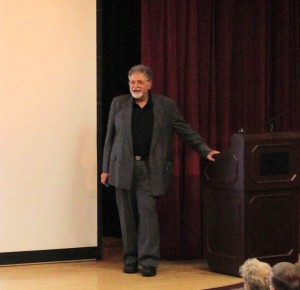 By then, Rauschenberg and his friend and GraphicStudio director, Don Saff, had already formulated the process that R.O.C.I. would follow. First, Saff would visit each potential host country to evaluate their interest, search for places to make and exhibit art, and arrange for authors, poets and local artists to assist not only in the creative process and but in putting together a catalogue of poetry, essays and photos for each show. Once plans had been finalized, Bob and a team of studio assistants would visit the country
By then, Rauschenberg and his friend and GraphicStudio director, Don Saff, had already formulated the process that R.O.C.I. would follow. First, Saff would visit each potential host country to evaluate their interest, search for places to make and exhibit art, and arrange for authors, poets and local artists to assist not only in the creative process and but in putting together a catalogue of poetry, essays and photos for each show. Once plans had been finalized, Bob and a team of studio assistants would visit the country 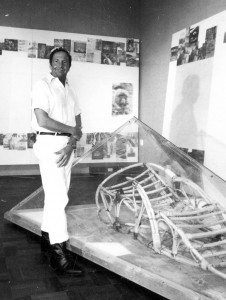 for 10 to 15 days, working with local creatives and travelling extensively to photograph and videotape the surrounding environs. During this time, Bob would also meet with dignitaries, teachers, intellectuals, artists and artisans, often footing the bill for dinners, drinks and associated entertainment. Then he would return to his studio in Captiva or go to GraphicStudio in Tampa to convert the knowledge of local customs and materials he’d gleaned as well as the volume of photos and video footage into culturally-based artworks like Chinese Summerhall or the 230 immense pieces he imprinted with flamboyant colors and myriad religious symbols he discovered during his visit to Mexico.
for 10 to 15 days, working with local creatives and travelling extensively to photograph and videotape the surrounding environs. During this time, Bob would also meet with dignitaries, teachers, intellectuals, artists and artisans, often footing the bill for dinners, drinks and associated entertainment. Then he would return to his studio in Captiva or go to GraphicStudio in Tampa to convert the knowledge of local customs and materials he’d gleaned as well as the volume of photos and video footage into culturally-based artworks like Chinese Summerhall or the 230 immense pieces he imprinted with flamboyant colors and myriad religious symbols he discovered during his visit to Mexico.
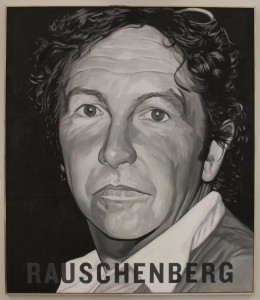 Once the works were completed, Rauschenberg would return to the host country. Sometimes there were so many pieces that they filled an entire Boeing 747 cargo jet. Bob not only supervised their installation, he presided as master of ceremonies during the opening receptions, participated in formal dinners, and gave lectures, Q&As and gallery talks to a legion of artists, art instructors, students and other while Saff and other members of Rauschenberg’s staff were scouting out the next destination.
Once the works were completed, Rauschenberg would return to the host country. Sometimes there were so many pieces that they filled an entire Boeing 747 cargo jet. Bob not only supervised their installation, he presided as master of ceremonies during the opening receptions, participated in formal dinners, and gave lectures, Q&As and gallery talks to a legion of artists, art instructors, students and other while Saff and other members of Rauschenberg’s staff were scouting out the next destination.
The cost was immense and it proved impossible to attract 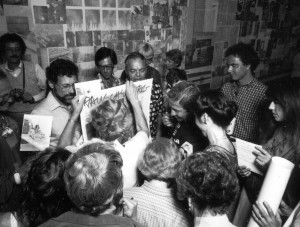 corporate or government sponsors for the trip. “To be government sponsored would defeat the idea of the project,” Rauschenberg explained at one point. “It has to be from people to people.” With neither grants nor sponsorships at his disposal, Rauschenberg had no choice. He mortgaged his beloved home and studio on Captiva and instructed Saff to sell the majority of his personal art collection. “Bob had me sell his wonderful
corporate or government sponsors for the trip. “To be government sponsored would defeat the idea of the project,” Rauschenberg explained at one point. “It has to be from people to people.” With neither grants nor sponsorships at his disposal, Rauschenberg had no choice. He mortgaged his beloved home and studio on Captiva and instructed Saff to sell the majority of his personal art collection. “Bob had me sell his wonderful 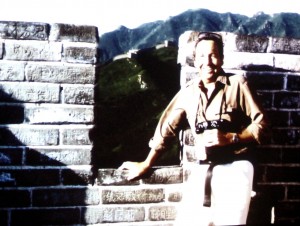 Twombley, his Jasper Johns and other works,” Saff concedes, “and thus he raised several plus million dollars to produce the show. And,” Saff hastens to add, “he didn’t sell any works because R.O.C.I. was not a commercial venture. It was cultural – intended to reach people through a cultural language, not a political language.”
Twombley, his Jasper Johns and other works,” Saff concedes, “and thus he raised several plus million dollars to produce the show. And,” Saff hastens to add, “he didn’t sell any works because R.O.C.I. was not a commercial venture. It was cultural – intended to reach people through a cultural language, not a political language.”
It’s possible that Rauschenberg anticipated 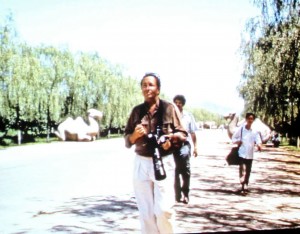 recouping some of this cost after R.O.C.I. ended, but the works were so large and culturally based that little market evolved for the works in the years following the tour’s end. R.O.C.I.’s symbol fittingly became a turtle carrying the world on its back, with Bob playing the turtle. “My pockets are empty,” he told an audience in Japan good naturedly even though he was on the verge of bankruptcy by then. “But to be government
recouping some of this cost after R.O.C.I. ended, but the works were so large and culturally based that little market evolved for the works in the years following the tour’s end. R.O.C.I.’s symbol fittingly became a turtle carrying the world on its back, with Bob playing the turtle. “My pockets are empty,” he told an audience in Japan good naturedly even though he was on the verge of bankruptcy by then. “But to be government  sponsored would defeat the idea of the project,” he reconciled. “It has to be from people to people.”
sponsored would defeat the idea of the project,” he reconciled. “It has to be from people to people.”
But Rauschenberg nonetheless landed on his feet. By the time of his death in 2008, his estate was reported to be worth in excess of $600 million. But for Bob, the money was besides the point. Rauschenberg had something important to say and, as R.O.C.I. so amply demonstrated, he was one artist who was always willing to put his money where his mouth was.
_____________________________________________________________________
Chinese cook’s story inspired Rauschenberg Overseas Cultural Interchange (10-29-14)
 Long before the Rauschenberg Overseas Cultural Interchange took shape in Bob Rauschenberg’s mind, the Anhui Gallery in California was trying to induce the artist to do a world tour of his art. Rauschenberg, after all, was a citizen of the world. He travelled extensively and regarded all the world as his palette. But he remained unconvinced that it
Long before the Rauschenberg Overseas Cultural Interchange took shape in Bob Rauschenberg’s mind, the Anhui Gallery in California was trying to induce the artist to do a world tour of his art. Rauschenberg, after all, was a citizen of the world. He travelled extensively and regarded all the world as his palette. But he remained unconvinced that it 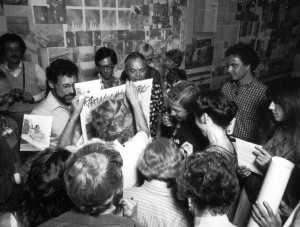 was his prerogative to embark upon such an ambitious undertaking. Nevertheless, he did take up Gemini G.E.L.’s offer to go to China to do a paper project at an ancient, 1,500-year-old paper mill in Jingxian. Ironically, it was a cook he met there who persuaded Rauschenberg that a global cultural tour was a necessity.
was his prerogative to embark upon such an ambitious undertaking. Nevertheless, he did take up Gemini G.E.L.’s offer to go to China to do a paper project at an ancient, 1,500-year-old paper mill in Jingxian. Ironically, it was a cook he met there who persuaded Rauschenberg that a global cultural tour was a necessity.
For a variety of reasons, the officials in charge of the 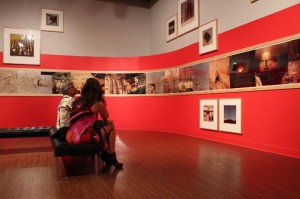 Xuan paper mill would not let Rauschenberg and his group actually work inside the facility itself. [Read the next article to find our why.] Instead, they agreed to let Rauschenberg send templates to the mill, which would then produce the paper he needed and send it back again. As a result, Rauschenberg spent day and night working inside the VIP compound outside the mill, and that’s where he met a Chinese cook who befriended him. The cook invited Bob into the kitchen and began to share recipes with
Xuan paper mill would not let Rauschenberg and his group actually work inside the facility itself. [Read the next article to find our why.] Instead, they agreed to let Rauschenberg send templates to the mill, which would then produce the paper he needed and send it back again. As a result, Rauschenberg spent day and night working inside the VIP compound outside the mill, and that’s where he met a Chinese cook who befriended him. The cook invited Bob into the kitchen and began to share recipes with 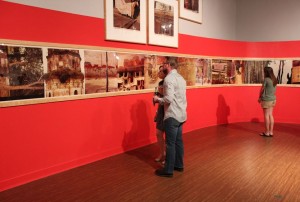 Bob, including one for Chinese dumplings. “While they were cooking one day, Bob asked, ‘Where’s your family?’,” recounts Don Saff, the GraphicStudio founder and director who accompanied Rauschenberg on the China trip. “The cook told him that his family was 25 miles away. Bob asked, ‘How often do you see them?’
Bob, including one for Chinese dumplings. “While they were cooking one day, Bob asked, ‘Where’s your family?’,” recounts Don Saff, the GraphicStudio founder and director who accompanied Rauschenberg on the China trip. “The cook told him that his family was 25 miles away. Bob asked, ‘How often do you see them?’ 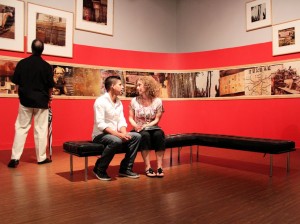 And the cook answered, ‘I don’t see them.’ So Bob asked, ‘When was the last time you did see them?’ And he answered, “Twenty-five years ago – because the paper work, bureaucracy and suspicions are too great for us to make the trip, to take that chance.'”
And the cook answered, ‘I don’t see them.’ So Bob asked, ‘When was the last time you did see them?’ And he answered, “Twenty-five years ago – because the paper work, bureaucracy and suspicions are too great for us to make the trip, to take that chance.'”
Rauschenberg was incredulous. “It was right then and there that the concept of going to sensitive 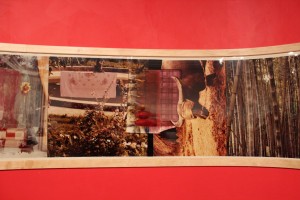 areas and showing them imagery became a reality,” Saff expounds. “If you couldn’t know what was going on 25 miles away, how could you know what was going on 2,500 miles away, or 10,000 miles away? So when we got back to Beijing, Bob said he wanted to do a world tour, ‘my world tour, and I want it to be an introduction of the world to itself through my art.’ And that’s what R.O.C.I.
areas and showing them imagery became a reality,” Saff expounds. “If you couldn’t know what was going on 25 miles away, how could you know what was going on 2,500 miles away, or 10,000 miles away? So when we got back to Beijing, Bob said he wanted to do a world tour, ‘my world tour, and I want it to be an introduction of the world to itself through my art.’ And that’s what R.O.C.I. 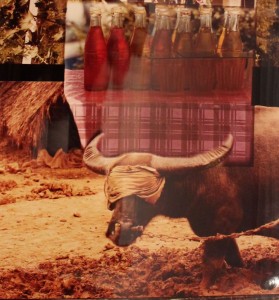 became and how it developed.”
became and how it developed.”
And one of the images that came to symbolize the insular life of people living in many of the countries that R.O.C.I. visited was a blindfolded water buffalo. [See “Blindfolded water buffalo epitomized Rauschenberg’s reaction to insular lives led by Chinese in 1982” (10-20-14), below.] Rauschenberg happened upon the water buffalo after leaving Jingxian. It had been blindfolded and made to walk continuously in a circle to power a mixer at a local brick factory. “It was blindfolded so he wouldn’t get 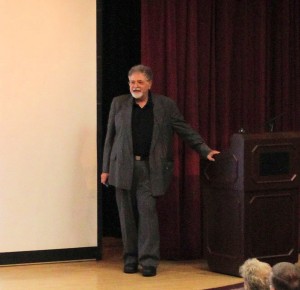 tipsy going around in circles hour after hour,” Saff explained during his RR to PRC to ROCI talk prior to the opening of RAUSCHENBERG: China/America Mix.
tipsy going around in circles hour after hour,” Saff explained during his RR to PRC to ROCI talk prior to the opening of RAUSCHENBERG: China/America Mix.
“That was his whole life,” Rauschenberg later said with incredulity. “If one isn’t moved by that ….”
“The metaphor for Bob was extraordinary. The cook can’t see his family 25 miles away and the water buffalo can’t see where he’s going, and the imagery begins to fold into Bob’s photography in 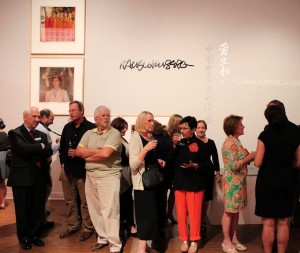 the same way his photography begins to get cut up into the [100-foot-photo] collage.”
the same way his photography begins to get cut up into the [100-foot-photo] collage.”
You can see the 100-foot-photo, titled Chinese Summerhall, along with examples of the paper projects, titled 7 Characters, that Rauschenberg made during and following his return from the 1982 China trip at the Bob Rauschenberg Gallery through December 17. They’re part of RAUSCHENBERG: China/America Mix, which opened October 22.
______________________________________________________________
Rauchenberg’s legendary work ethic won over Chinese handlers during stopover outside Xuan paper mill in Jing Xian (10-28-14)
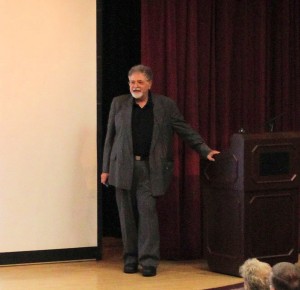 “Bob Rauschenberg was indefatigable in terms of producing his art,” declared Donald Saff during his RR to PRC to ROCI talk prior to the October 22 opening of RAUSCHENBERG: China/America Mix. “Those of us who knew him saw that he was working all the time, and when he wasn’t working, he was thinking about work.” Rauschenberg’s former studio assistant Lawrence Voytek could be seen nodding his agreement in the front row of the Rush Auditorium.
“Bob Rauschenberg was indefatigable in terms of producing his art,” declared Donald Saff during his RR to PRC to ROCI talk prior to the October 22 opening of RAUSCHENBERG: China/America Mix. “Those of us who knew him saw that he was working all the time, and when he wasn’t working, he was thinking about work.” Rauschenberg’s former studio assistant Lawrence Voytek could be seen nodding his agreement in the front row of the Rush Auditorium.
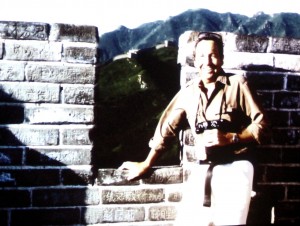 “There was a television on 24 hours a day so that the world was constantly invading the interior of his home and the interior of his mind,” continued Saff, who knew Rauschenberg well, both as the founder and director of USF’s GraphicStudio and the advance man for and artistic director of the artist’s 1985-1990 world tour known as R.O.C.I. or the Rauschenberg Overseas Cultural Interchange.
“There was a television on 24 hours a day so that the world was constantly invading the interior of his home and the interior of his mind,” continued Saff, who knew Rauschenberg well, both as the founder and director of USF’s GraphicStudio and the advance man for and artistic director of the artist’s 1985-1990 world tour known as R.O.C.I. or the Rauschenberg Overseas Cultural Interchange. 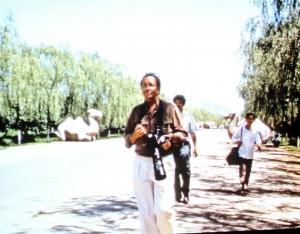 “This stimuli, as well as all the people who would come by and visit him, would feed into the broad palette of ideas and techniques that he had learned from many of the artisans he had met.”
“This stimuli, as well as all the people who would come by and visit him, would feed into the broad palette of ideas and techniques that he had learned from many of the artisans he had met.”
Rauschenberg’s work ethic certainly impressed his hosts during his visit to China in 1982 to do a paper project in the 1,500-year-old Xuan paper mill in Jing Xian. After being delayed in the Yellow 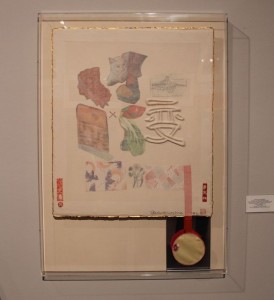 Mountains for more than a week, Rauschenberg was eager to make some art when he, Saff and his group finally arrived at the VIP compound outside the mill. But more complications thwarted Bob’s creative impulses. “In the end,” Saff said, “we worked out a system in which we would cut up posters [that Bob had collected during the course of the China trip], lay them out on a template and [our Chinese handlers] would carry them back and forth to the mill.”
Mountains for more than a week, Rauschenberg was eager to make some art when he, Saff and his group finally arrived at the VIP compound outside the mill. But more complications thwarted Bob’s creative impulses. “In the end,” Saff said, “we worked out a system in which we would cut up posters [that Bob had collected during the course of the China trip], lay them out on a template and [our Chinese handlers] would carry them back and forth to the mill.”
Finally clear of the bureaucratic red tape that had been restraining them, Rauschenberg and his group worked 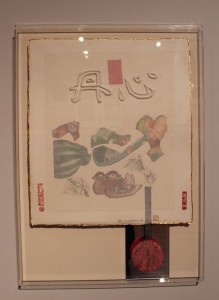 day and night. “Now in most socialist countries, you make believe you work and they make believe they pay you, but they didn’t understand Bob’s work ethic. He got up early and immediately went to work. He had people he trusted and they went to work too. And he hung his art all around. They had never seen anything like that and so they started staying at the VIP compound to watch, particularly the cooks.”
day and night. “Now in most socialist countries, you make believe you work and they make believe they pay you, but they didn’t understand Bob’s work ethic. He got up early and immediately went to work. He had people he trusted and they went to work too. And he hung his art all around. They had never seen anything like that and so they started staying at the VIP compound to watch, particularly the cooks.”
One of the cooks befriended Rauschenberg, and even taught him how to make Chinese dumplings,” Saff reminisced. And although he probably never knew it, that cook told Rauschenberg something that changed Bob’s life and inspired one of the world’s greatest 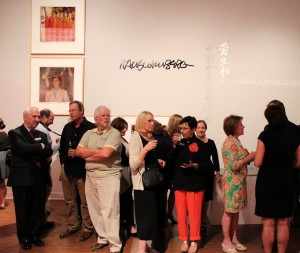 artists to embark upon a 10-nation, 5-year worldwide cultural tour that continues to influence artists across the globe even today.
artists to embark upon a 10-nation, 5-year worldwide cultural tour that continues to influence artists across the globe even today.
What did the cook say? Well, for the answer to that question you will need to read tomorrow’s post.
RAUSCHENBERG: China/America Mix is a solo show of work Robert Rauschenberg completed during and following a trip to the People’s Republic of China in 1982. On exhibit at the Bob 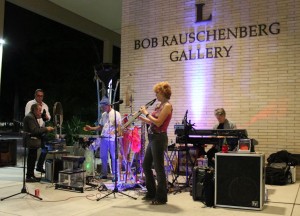 Rauschenberg Gallery on the Lee campus of Florida SouthWestern State College, the show runs through December 17, 2014. The Bob Rauschenberg Gallery was founded as The Gallery of Fine Art in 1979 and was renamed on June 4, 2004 as the Bob Rauschenberg Gallery to honor and commemorate its long association and friendship with the artist.
Rauschenberg Gallery on the Lee campus of Florida SouthWestern State College, the show runs through December 17, 2014. The Bob Rauschenberg Gallery was founded as The Gallery of Fine Art in 1979 and was renamed on June 4, 2004 as the Bob Rauschenberg Gallery to honor and commemorate its long association and friendship with the artist.
_________________________________________________________________
How a bit of trickery led to inclusion of a political poster in the ‘Chinese Summerhall’ 100-foot photo (10-27-14)
 Every work of art has a story, and the intriguing stories surrounding the works included in China/America Mix add powerfully to the allure of these pieces, both individually and as a collective whole.
Every work of art has a story, and the intriguing stories surrounding the works included in China/America Mix add powerfully to the allure of these pieces, both individually and as a collective whole.
Included in Chinese Summerhall is a photograph of a political poster Mao, Stalin, Trotsky and Marx. But the photo almost didn’t make it into the collage. Rauschenberg and his party came across it while they were in Shanghai during their 1982 visit 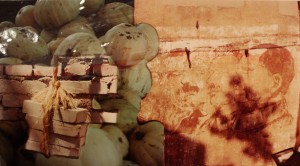 to China. “Although there was very little advertising and few commercial posters at that time, there were political posters around like this one,” recalls former GraphicStudio founder and director Donald Saff, who accompanied Rauschenberg on the 1982 trip. “So Bob takes a
to China. “Although there was very little advertising and few commercial posters at that time, there were political posters around like this one,” recalls former GraphicStudio founder and director Donald Saff, who accompanied Rauschenberg on the 1982 trip. “So Bob takes a 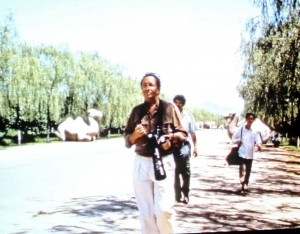 picture of it and as a policeman runs up, Bob hands me the camera. So I’m holding the camera, and I can do a little magic, and I see immediately what’s happening. I pulled a blank roll of film out my pocket and when the policeman demanded the film in the camera, I opened the back, palmed the film and handed him the blank film.” The policeman never knew that Saff had duped him.
picture of it and as a policeman runs up, Bob hands me the camera. So I’m holding the camera, and I can do a little magic, and I see immediately what’s happening. I pulled a blank roll of film out my pocket and when the policeman demanded the film in the camera, I opened the back, palmed the film and handed him the blank film.” The policeman never knew that Saff had duped him.
 But there’s more to the story. “When we came back later, Bob wanted to get another shot of the poster. It was gone,” exclaims Saff. “It was gone.” Thus, Saff had preserved the only shot Bob got of the poster and Rauschenberg duly chose it for inclusion in the 100-foot photo.
But there’s more to the story. “When we came back later, Bob wanted to get another shot of the poster. It was gone,” exclaims Saff. “It was gone.” Thus, Saff had preserved the only shot Bob got of the poster and Rauschenberg duly chose it for inclusion in the 100-foot photo.
Chinese Summerhall is part of RAUSCHENBERG: China/America Mix, a solo show of work Robert Rauschenberg completed during and upon returning back in Captiva following a trip to the People’s Republic of China in 1982. RAUSCHENBERG: China/America Mix runs through December 17, 2014.
___________________________________________________________________
‘China/America Mix’ exhibition offers greater understanding and appreciation of Rauschenberg’s R.O.C.I. legacy (10-26-14)
 RAUSCHENBERG: China/America Mix opened on October 22. The exhibition contains work that the artist created during and following his return to Captiva from a trip he made to China in 1982. Among the work on display are several pieces from his 7 Characters series, a number of the studies he did for a 100-foot-long photo-collage titled Chinese Summerhall, and the impressive
RAUSCHENBERG: China/America Mix opened on October 22. The exhibition contains work that the artist created during and following his return to Captiva from a trip he made to China in 1982. Among the work on display are several pieces from his 7 Characters series, a number of the studies he did for a 100-foot-long photo-collage titled Chinese Summerhall, and the impressive  photo-collage itself. The exhibition is the first solo exhibition of Rauschenberg’s work at the Bob Rauschenberg Gallery since the memorial show that following the artist’s death in 2008. It is also the 16th solo show of Rauschenberg’s work at the gallery at Florida SouthWestern State College, which was renamed and dedicated in the artist’s honor ten years ago.
photo-collage itself. The exhibition is the first solo exhibition of Rauschenberg’s work at the Bob Rauschenberg Gallery since the memorial show that following the artist’s death in 2008. It is also the 16th solo show of Rauschenberg’s work at the gallery at Florida SouthWestern State College, which was renamed and dedicated in the artist’s honor ten years ago.
 Each of the works included in this dramatically-staged exhibition is magnificent in its own right. But every work of art has a story, and the intriguing stories surrounding the works included in China/America Mix add powerfully to the allure of these pieces, both individually and as a collective whole.
Each of the works included in this dramatically-staged exhibition is magnificent in its own right. But every work of art has a story, and the intriguing stories surrounding the works included in China/America Mix add powerfully to the allure of these pieces, both individually and as a collective whole.
The 7 Characters series was made at the 1,500-year-old Xuan paper mill in Jing Xian, China from handmade paper so enduring that it was used by the Chinese to record their most important documents and for artistic scrolls. “What Bob did was he took the world’s most  diaphanous paper,” explained GraphicStudio founder and director Don Saff during his RR to PRC to ROCI talk prior to last Wednesday night’s opening. “You could almost see through it, like glass, and Bob used the delicateness of the paper, but he also laminated 30 sheets together so that he had this thick laminate, delicate paper and paper pulp. He was going to exhaust every possibility.”
diaphanous paper,” explained GraphicStudio founder and director Don Saff during his RR to PRC to ROCI talk prior to last Wednesday night’s opening. “You could almost see through it, like glass, and Bob used the delicateness of the paper, but he also laminated 30 sheets together so that he had this thick laminate, delicate paper and paper pulp. He was going to exhaust every possibility.”
But Rauschenberg did not stop there. “He also had these images of ubiquitous symbols which he said he was putting into the stomach of the paper,” continued Saff, who accompanied Rauschenberg on the 1982 China visit. “He was putting the art into the stomach of the 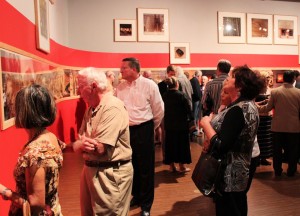 paper, and as 7 Characters reflects, that’s exactly what he did.”
paper, and as 7 Characters reflects, that’s exactly what he did.”
Before and following his time in Jing Xian, Rauschenberg took hundreds of photographs as he toured the cities and countryside of China. From this archive, he and the artisans at GraphicStudio culled just 52 shots, and from these, he chose 18 images for a limited edition series of 30 x 40 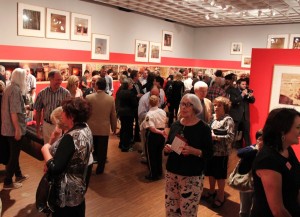 inch studies and 10 more for a limited edition run of 24 x 30 inch studies. “From Bob’s perspective, individual prints within an edition could vary,” said Saff, as he described the process by which the Studies for Chinese Summerhall were produced. “Bob didn’t feel like he had to adhere to them all being identical. Bob didn’t like giving a work of art to an artisan, then going away and coming back
inch studies and 10 more for a limited edition run of 24 x 30 inch studies. “From Bob’s perspective, individual prints within an edition could vary,” said Saff, as he described the process by which the Studies for Chinese Summerhall were produced. “Bob didn’t feel like he had to adhere to them all being identical. Bob didn’t like giving a work of art to an artisan, then going away and coming back 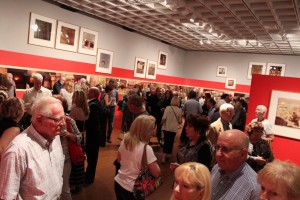 just to sign the work. Bob wanted to be part of the creative process every inch of the way because there was always an opportunity that way. If you gave the work to an artisan, the opportunities evaporated.”
just to sign the work. Bob wanted to be part of the creative process every inch of the way because there was always an opportunity that way. If you gave the work to an artisan, the opportunities evaporated.”
Many of these studies are hung up in the sky in the gallery and above the main attraction, Chinese Summerhall.
 Just to say that Rauschenberg collaged 52 photographs into a photograph that is 100 feet long doesn’t convey the scope and scale of the project. Chinese Summerhall was unlike any photo of its time. It was printed on an uninterrupted scroll of photo-sensitive paper made by the Eastman Kodak company. “There couldn’t be any light during the printing process,” Saff told the SRO audience during his pre-opening talk last Wednesday. “So [Rauschenberg and the
Just to say that Rauschenberg collaged 52 photographs into a photograph that is 100 feet long doesn’t convey the scope and scale of the project. Chinese Summerhall was unlike any photo of its time. It was printed on an uninterrupted scroll of photo-sensitive paper made by the Eastman Kodak company. “There couldn’t be any light during the printing process,” Saff told the SRO audience during his pre-opening talk last Wednesday. “So [Rauschenberg and the 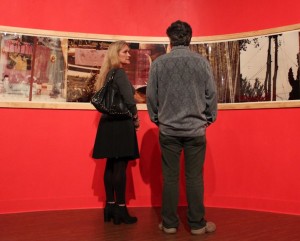 GraphicStudio artisans] were working in the dark. They actually had to make 25 collages to get 5 [keepers]. If the registration marks didn’t line up, they’d have to go back and start the process all over again from the beginning, and all of this was done in the dark.”
GraphicStudio artisans] were working in the dark. They actually had to make 25 collages to get 5 [keepers]. If the registration marks didn’t line up, they’d have to go back and start the process all over again from the beginning, and all of this was done in the dark.”
“At the time, it was the most ambitious photograph ever printed,” relates Bob Rauschenberg Gallery Director Jade Dellinger, who adds that the work  had to be done after nightfall in a large blackened out commercial space that was formerly a grocery store.
had to be done after nightfall in a large blackened out commercial space that was formerly a grocery store.
Today, the 100-foot-photograph, Chinese Summerhall, hangs on three specially-constructed curved walls that have been painted Chinese red. The effect is nothing short of breathtaking, and the only thing missing from the exhibition are some of the paper sculptures that Rauschenberg made during the China trip.
Since assuming the directorship of the gallery, Jade Dellinger has sought to extend and expand upon Bob Rauschenberg’s legacy. For a variety of reasons, 7 Characters was not a critical success  here in the United States, nor were the majority of works that Rauschenberg did in the host countries that his R.O.C.I. project visited. The problem, of course, was that Rauschenberg was decades ahead of his time. While R.O.C.I. visited insular, isolated countries, the U.S. and European art markets were just as insular when it came to appreciating artworks based on other cultures. Those artworks are better understood today, in a global economy
here in the United States, nor were the majority of works that Rauschenberg did in the host countries that his R.O.C.I. project visited. The problem, of course, was that Rauschenberg was decades ahead of his time. While R.O.C.I. visited insular, isolated countries, the U.S. and European art markets were just as insular when it came to appreciating artworks based on other cultures. Those artworks are better understood today, in a global economy  characterized by cross-culturalism. But the learning process starts not here, on a website that talks about the exhibition, but standing before the work inside the Bob Rauschenberg Gallery.
characterized by cross-culturalism. But the learning process starts not here, on a website that talks about the exhibition, but standing before the work inside the Bob Rauschenberg Gallery.
RAUSCHENBERG: China/America Mix runs through December 17, 2014.
The Bob Rauschenberg Gallery was founded as The Gallery of Fine Art in 1979 on the Lee County campus of Florida SouthWestern State College/FSW (then Edison Community College). On June 4, 2004 the Gallery of Fine Art was renamed the Bob Rauschenberg Gallery to honor and commemorate its long association and friendship with the artist
__________________________________________________________________________
Getting to know Bob Rauschenberg the artist and ambassador of peace through R.O.C.I. Artistic Director Donald Saff (10-24-14)
 If you have ever heard Terry Gross interview Billy Crystal on NPR’s Fresh Air radio show, then you have sampled the flavor of the tasty dish served up by Donald Saff during his talk last Wednesday evening prior to the opening of RAUSCHENBERG: China/America Mix. Besides being the founder and director of USF’s GraphicStudio at the time, Saff served as the Artistic Director and advance man for the Rauschenberg Overseas Cultural Interchange. But Saff did not merely provide the background for how Rauchenberg and he
If you have ever heard Terry Gross interview Billy Crystal on NPR’s Fresh Air radio show, then you have sampled the flavor of the tasty dish served up by Donald Saff during his talk last Wednesday evening prior to the opening of RAUSCHENBERG: China/America Mix. Besides being the founder and director of USF’s GraphicStudio at the time, Saff served as the Artistic Director and advance man for the Rauschenberg Overseas Cultural Interchange. But Saff did not merely provide the background for how Rauchenberg and he 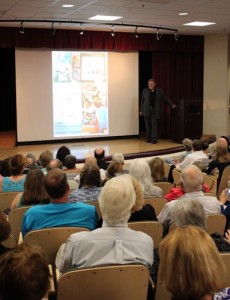 conceived and carried out Bob’s seminal trip to China in 1982 and ROCI’s subsequent 1985 exhibition in Beijing. As one of Bob’s dearest friends and closest confidantes, he entertained the SRO Rush Auditorium crowd with a medley of inside stories, humorous anecdotes and pithy insights into both the tour and the artist himself.
conceived and carried out Bob’s seminal trip to China in 1982 and ROCI’s subsequent 1985 exhibition in Beijing. As one of Bob’s dearest friends and closest confidantes, he entertained the SRO Rush Auditorium crowd with a medley of inside stories, humorous anecdotes and pithy insights into both the tour and the artist himself.
Just as Rauschenberg gave the people in the countries R.O.C.I. visited the rare privilege of seeing themselves through his eyes and keen intellect, Saff gave the China/America Mix audience the unparalleled opportunity to see Bob through the prism of his own colorful view of a man he not only admired but clearly loved and 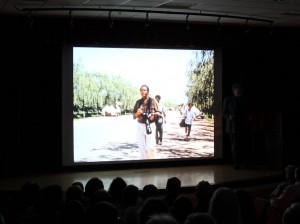 greatly misses. “Bob’s not gone,” Saff insisted from the outset of his remarks. “He’s over in that gallery and is still very much a part of our lives.”
greatly misses. “Bob’s not gone,” Saff insisted from the outset of his remarks. “He’s over in that gallery and is still very much a part of our lives.”
Considering his long and illustrious career, Saff was certainly Rauschenberg’s equal, but you’d never know it from the stories the self-deprecating Saff told last Wednesday night. Rauschenberg had a camera with a long, heavy lens. “He only carried  it on flat ground,” Saff chuckled. “He gave it to me to carry whenever it came time to climb up a hill.”
it on flat ground,” Saff chuckled. “He gave it to me to carry whenever it came time to climb up a hill.”
Bob also handed the camera to Saff when a policeman came running up one day after Bob snapped a shot of a sensitive political poster he happened upon in Shanghai. “I saw immediately what was happening,” Saff recounted. “I can work a little magic, so I reached into my pocket and 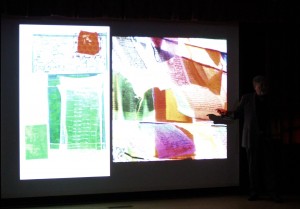 pulled out a spare roll of film. When the policeman demanded the film, I opened the back of the camera, palmed the film and handed him the blank roll I’d had in my pocket.”
pulled out a spare roll of film. When the policeman demanded the film, I opened the back of the camera, palmed the film and handed him the blank roll I’d had in my pocket.”
It was that kind of cool resourcefulness that induced Rauschenberg to invite Saff to Captiva on his birthday eve in October of 1981. “He’d been invited by Gemini G.E.L. in California to do a 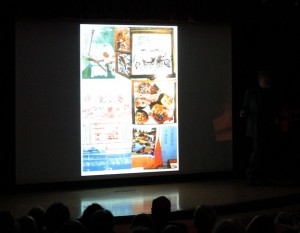 paper project at the [1,500-year-old] Huan paper mill [in Jing Xian, China]. Bob wasn’t afraid of anything, but he did have some concerns.” He wanted the Chinese to take him seriously, so he asked Saff to bring along a book he’d co-authored that contained a chapter on paper making as an art form.
paper project at the [1,500-year-old] Huan paper mill [in Jing Xian, China]. Bob wasn’t afraid of anything, but he did have some concerns.” He wanted the Chinese to take him seriously, so he asked Saff to bring along a book he’d co-authored that contained a chapter on paper making as an art form.
“Bob wanted to bring along the book to show the 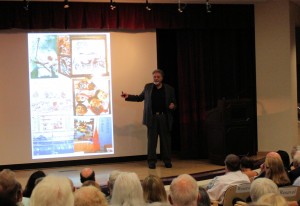 Chinese that we were really qualified to work at this paper mill,” Saff recounts. But the book was apparently so authoritative that the officials in charge of the paper mill became fearful that Rauschenberg and his group were actually coming to steal their centuries-old paper-making secrets.
Chinese that we were really qualified to work at this paper mill,” Saff recounts. But the book was apparently so authoritative that the officials in charge of the paper mill became fearful that Rauschenberg and his group were actually coming to steal their centuries-old paper-making secrets.
“When we got to the Yellow Mountains, there was 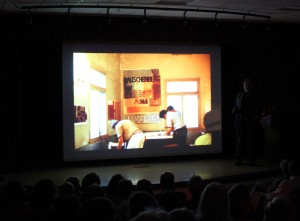 a delay,” Saff explained. Their chaperones did not tell them that the people in charge of the mill suspected they were there to commit industrial espionage. “The excuse they gave us was that when the paper makers get into the vat with the pulp, they’re nude. They move the pulp around the vat nude. Well, Bob’s face lit up and you know that Bob is thinking whatever he’s thinking and you
a delay,” Saff explained. Their chaperones did not tell them that the people in charge of the mill suspected they were there to commit industrial espionage. “The excuse they gave us was that when the paper makers get into the vat with the pulp, they’re nude. They move the pulp around the vat nude. Well, Bob’s face lit up and you know that Bob is thinking whatever he’s thinking and you 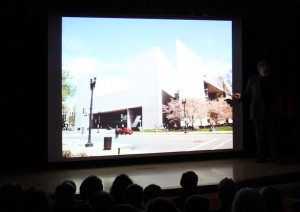 know there’s a performance piece that’s going to come out of all this when it’s over.” Nevertheless, there they sat.
know there’s a performance piece that’s going to come out of all this when it’s over.” Nevertheless, there they sat.
“A day goes by,” Saff continued. “Then a week goes by.” Rauschenberg would later say in an interview that he forced the issue by refusing to stay any longer in the Yellow Mountain guesthouse. Saff recalled the episode a little differently.
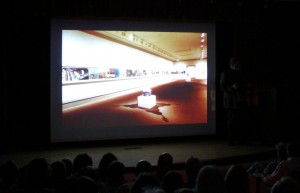 “I suggested [to one of the women in our group] that she lock herself in her room, which she did. And when our chaperones got concerned, I said, ‘We’re knocking on the door and she won’t come out of her room and I’m really afraid she could hurt herself. She’s very depressed about not getting to go to the paper mill. We planned that. I
“I suggested [to one of the women in our group] that she lock herself in her room, which she did. And when our chaperones got concerned, I said, ‘We’re knocking on the door and she won’t come out of her room and I’m really afraid she could hurt herself. She’s very depressed about not getting to go to the paper mill. We planned that. I 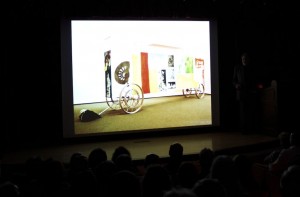 tried to speak to her, but she’s very difficult.’ And she really was difficult. But 15 minutes later, the door was unlocked, and half an hour later, we were on the bus heading for Jing Xian.”
tried to speak to her, but she’s very difficult.’ And she really was difficult. But 15 minutes later, the door was unlocked, and half an hour later, we were on the bus heading for Jing Xian.”
Unfortunately, their problems weren’t over. They got no further than the VIP compound in Jing Xian. “The Chinese were so convinced that we were 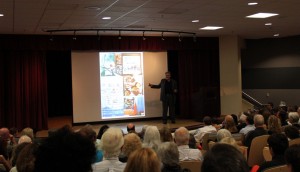 there to steal their ideas that they would walk into our room at night to make sure we were sleeping. So they decided they were going to bring a paper maker to this VIP compound. It was a real thin old man. And he just stood there like [Herman Melville’s] Bartleby the Scrivener. He refused. He just refused to work. In the end, we worked out a
there to steal their ideas that they would walk into our room at night to make sure we were sleeping. So they decided they were going to bring a paper maker to this VIP compound. It was a real thin old man. And he just stood there like [Herman Melville’s] Bartleby the Scrivener. He refused. He just refused to work. In the end, we worked out a 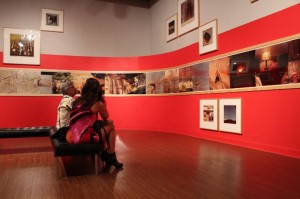 system in which we would cut up these posters, lay them out on a template and they’d carry that back and forth to the mill.”
system in which we would cut up these posters, lay them out on a template and they’d carry that back and forth to the mill.”
Saff’s resourcefulness and diplomacy would come in handy many more times throughout the 1962 trip and during the course of the R.O.C.I. world tour. But Saff would be the first to object that 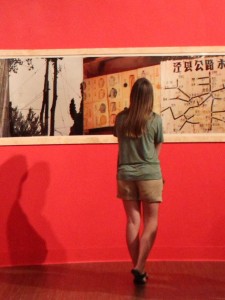 neither the China visit nor R.O.C.I. was in the least little bit about him.
neither the China visit nor R.O.C.I. was in the least little bit about him.
In the microcosm of each host country that R.O.C.I. visited, Saff summed it up like this. “R.O.C.I. was taking images of these countries solely through [Bob’s] eyes and bringing it back to them so that they could see things in a different light. To give them license to go beyond the template of their own approach to their art, to the historically mired approach that many of the artists in these countries had because of a lack of seeing alternatives.”
And in the macrocosm of world peace, Saff observes, “Although 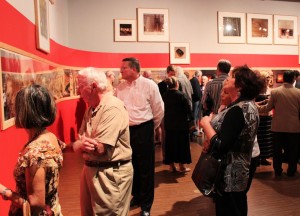 R.O.C.I. was apolitical, it is mindboggling to contemplate the contribution that Robert Rauschenberg made to diplomacy around the world. Each work of art he gave [the host countries] was like an ambassador because Bob felt if we can these people together socially, maybe something good could happen. He never thought we’d have peace in our time because of what he did, but he did think that he had contributions to make through his art, and nobody was going to get in his way.
R.O.C.I. was apolitical, it is mindboggling to contemplate the contribution that Robert Rauschenberg made to diplomacy around the world. Each work of art he gave [the host countries] was like an ambassador because Bob felt if we can these people together socially, maybe something good could happen. He never thought we’d have peace in our time because of what he did, but he did think that he had contributions to make through his art, and nobody was going to get in his way.
“And nobody did.
“And the world is better for it.”
__________________________________________________________________________________
The making and exhibition history of Rauschenberg’s 100-foot-photo, ‘Chinese Summerhall’ (10-21-14)
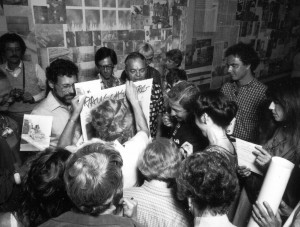 During his 1982 visit to China, Bob Rauschenberg took hundreds of photographs. To be sure, he took pictures of murals, monuments and places like the Great Wall of China that attract tourists like you and me. But for the artist who once proposed to “photograph the country inch by inch,” the camera wasn’t merely a means of recording where he had been. For Bob Rauschenberg, photography was a tool. It served as a medium that uniquely enabled
During his 1982 visit to China, Bob Rauschenberg took hundreds of photographs. To be sure, he took pictures of murals, monuments and places like the Great Wall of China that attract tourists like you and me. But for the artist who once proposed to “photograph the country inch by inch,” the camera wasn’t merely a means of recording where he had been. For Bob Rauschenberg, photography was a tool. It served as a medium that uniquely enabled 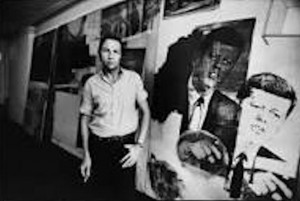 him to organize the chaos he saw all around into a more evolved, cogent world view. And so include in the took copious shots he took during his ’82 China trip were images of cart wheels, exotic plants, store windows, street scenes, markets, food, Coke bottles and a blindfolded water buffalo that was made to continuously walk in a circle in order to power a mixing machine in a factory that made bricks.
him to organize the chaos he saw all around into a more evolved, cogent world view. And so include in the took copious shots he took during his ’82 China trip were images of cart wheels, exotic plants, store windows, street scenes, markets, food, Coke bottles and a blindfolded water buffalo that was made to continuously walk in a circle in order to power a mixing machine in a factory that made bricks.
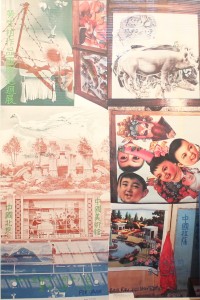 University of South Florida GraphicStudio founder and director Donald Saff accompanied Rauschenberg on that trip, and when he and Bob returned to the United States, they made a beeline for GraphicStudio, where they winnowed Bob’s photo archive to 52 iconic images. As GraphicStudio’s website so eloquently states today, “each image witnesses [Rauschenberg’s] remarkable eye and generous vision of life.”
University of South Florida GraphicStudio founder and director Donald Saff accompanied Rauschenberg on that trip, and when he and Bob returned to the United States, they made a beeline for GraphicStudio, where they winnowed Bob’s photo archive to 52 iconic images. As GraphicStudio’s website so eloquently states today, “each image witnesses [Rauschenberg’s] remarkable eye and generous vision of life.”
Rauschenberg then chose 18 of these images for a limited edition series of 30 x 40 inch studies and 10 more for a limited edition run of 24 x 30 inch studies. Then he and the GraphicStudio artisans trimmed the negatives of all 52 images and collaged them into a color photo called Chinese Summerhall. But Chinese Summerhall was unlike any photo of 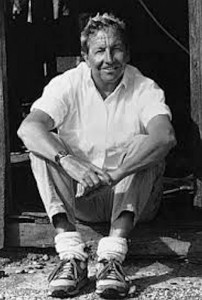 its time. It was printed on an uninterrupted scroll of photo-sensitive paper made by the Eastman Kodak company.
its time. It was printed on an uninterrupted scroll of photo-sensitive paper made by the Eastman Kodak company.
“At the time, it was the most ambitious photograph ever printed,” relates Bob Rauschenberg Gallery Director Jade Dellinger. In fact, the work had to be done after nightfall in a large blackened out commercial space that was formerly a grocery store.
Rauschenberg was so eager to share Chinese Summerhall with the public that he scheduled a New Year’s Eve opening for the piece at Leo Castilli Gallery in SoHo (along with large-scale ceramic pieces he made on the way home from China during a stopover in Japan). “I thought our 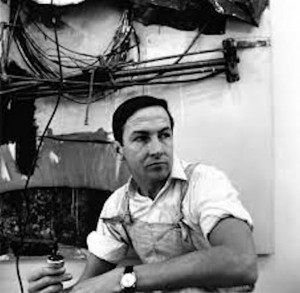 opening would remind people how interesting and lively art can be,” Rauschenberg told New York Times art critic Barbara Rowes in a January, 1983 interview.
opening would remind people how interesting and lively art can be,” Rauschenberg told New York Times art critic Barbara Rowes in a January, 1983 interview.
Bob took Chinese Summerhall with him when the Rauschenberg Overseas Cultural Interchange, or R.O.C.I., visited the China Art Gallery (now the National Museum of China) in Beijing in 1985. Some 70,000 people took in the 98-piece show in just the first week, with more than 300,000 flocking to the exhibit by the time the extravaganza ended its six-week run.
From there, Rauschenberg dispatched Chinese 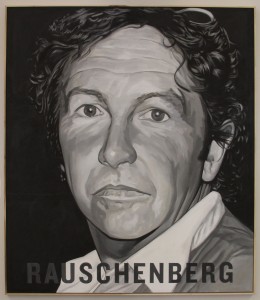 Summerhall to Havana for the R.O.C.I. exhibit his assistant Lawrence Voytek staged there. Then the 100-foot photograph travelled to Washington D.C., where it was twice shown by the National Gallery of Art, once in a GraphicStudio retrospective and then again in a special R.O.C.I. exhibition in 1990 that occupied the entire ground floor and concourse of the Museum’s east building. Organized by National Gallery Curator of 20th Century Art Jack Cowart with assistance from Saff (who in addition to discharging his duties at GraphicStudio served as R.O.C.I. Artist Director), the show included 60 paintings, 21
Summerhall to Havana for the R.O.C.I. exhibit his assistant Lawrence Voytek staged there. Then the 100-foot photograph travelled to Washington D.C., where it was twice shown by the National Gallery of Art, once in a GraphicStudio retrospective and then again in a special R.O.C.I. exhibition in 1990 that occupied the entire ground floor and concourse of the Museum’s east building. Organized by National Gallery Curator of 20th Century Art Jack Cowart with assistance from Saff (who in addition to discharging his duties at GraphicStudio served as R.O.C.I. Artist Director), the show included 60 paintings, 21 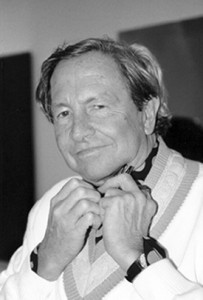 sculptures, 60 photographs, 30 graphic works and 15 video monitors. Each of the countries R.O.C.I. visited were represented, and before it closed, nearly 415,000 people turned out for the exhibition.
sculptures, 60 photographs, 30 graphic works and 15 video monitors. Each of the countries R.O.C.I. visited were represented, and before it closed, nearly 415,000 people turned out for the exhibition.
Although copies of the 100-foot photograph are in the permanent collections of the National Gallery, Solomon R. Guggenheim Gallery and Contemporary Art Museum at the University of South Florida in Tampa, Chinese Summerhall has been sparsely exhibited since then. “To my knowledge, the last time Chinese Summerhall was exhibited was [at the Contemporary Art Museum at USF] in 2001,” Dellinger told WGCU’s John Davis on Gulf Coast Live last week (October 15). Part of the reason the piece is rarely shown are the difficulties 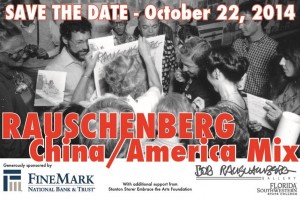 attendant with unpacking and installing a 100-foot-long collaged color photograph. When Dellinger too Chinese Summerhall out of storage for a major GraphicStudio retrospective that he curated a year ago at the Tampa Museum of Art, he found that the piece needed time-consuming conservation and maintenance before it could be properly displayed. While the work could not be completed in time for the GraphicStudio retrospective, the Contemporary Art Museum has graciously agreed
attendant with unpacking and installing a 100-foot-long collaged color photograph. When Dellinger too Chinese Summerhall out of storage for a major GraphicStudio retrospective that he curated a year ago at the Tampa Museum of Art, he found that the piece needed time-consuming conservation and maintenance before it could be properly displayed. While the work could not be completed in time for the GraphicStudio retrospective, the Contemporary Art Museum has graciously agreed 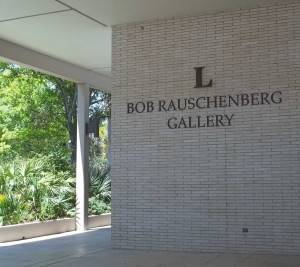 to loan Chinese Summerhall to the Bob Rauschenberg Gallery for RAUSCHENBERG: China/America Mix.
to loan Chinese Summerhall to the Bob Rauschenberg Gallery for RAUSCHENBERG: China/America Mix.
For the China/America Mix exhibition, Dellinger and his curatorial team have been compelled to make substantial modifications to the gallery space. Special walls with rounded corners were required to properly show the photograph. The exhibition also includes the 28 Studies for Chinese Summerhall plus a paper collage piece titled 7 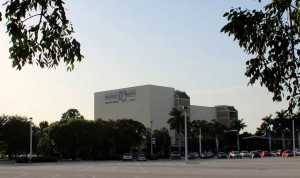 Characters thanks to a loan from local resident Fran Fenning, who acquired the work with her late husband, John, for their private collection. Fort Myers News Press art journalist Charles Runnells notes that 7 Characters “incorporates silk ribbon, gold leaf, cloth medallions, imagery from Chinese propaganda posters and seven Chinese symbols for
Characters thanks to a loan from local resident Fran Fenning, who acquired the work with her late husband, John, for their private collection. Fort Myers News Press art journalist Charles Runnells notes that 7 Characters “incorporates silk ribbon, gold leaf, cloth medallions, imagery from Chinese propaganda posters and seven Chinese symbols for 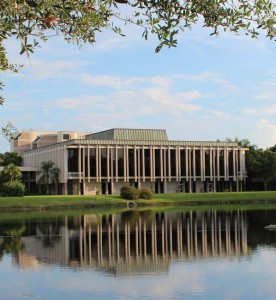 concepts including ‘truth,’ ‘individual’ and ‘red heart.'”
concepts including ‘truth,’ ‘individual’ and ‘red heart.'”
RAUSCHENBERG: China/America Mix opens to the public from 7-9 p.m. on Bob Rauschenberg’s birthday tomorrow, October 22. The opening will also feature musical performances by longtime friends Dickie Landry, Kat Epple and Sonic Combine. A pre-opening lecture on “Rauschenberg in China” will be presented from 6-7 p.m. by distinguished guest Dr. Donald Saff, who not only served as Founder of USF’s Graphicstudio, but as Artistic Director of Rauschenberg Overseas Culture Interchange/ROCI.
______________________________________________________________________
Blindfolded water buffalo epitomized Rauschenberg’s reaction to insular lives led by Chinese in 1982 (10-20-14)
 At the height of his artistic celebrity in 1982, Robert Rauschenberg decided to visit China. His experiences there would serve as impetus for the worldwide arts and culture tour he launched from the United Nations three years later. But “without the 1982 trip,” concedes Bob Rauschenberg Gallery Director Jade Dellinger, “R.O.C.I. (short for Rauschenberg Overseas Cultural Interchange) might never have taken place.”
At the height of his artistic celebrity in 1982, Robert Rauschenberg decided to visit China. His experiences there would serve as impetus for the worldwide arts and culture tour he launched from the United Nations three years later. But “without the 1982 trip,” concedes Bob Rauschenberg Gallery Director Jade Dellinger, “R.O.C.I. (short for Rauschenberg Overseas Cultural Interchange) might never have taken place.”
The ’82 trip nearly ended before it started. Rauschenberg wanted to make art in a 1,500-year-old paper mill located in Jingxuan. According to Barbara Rose, it took Bob, print atelier Gemini G.E.L. and the Anhui Artists’ Association more than two years to secure permission to work  at the mill. But when Rauschenberg and his entourage arrived, the Chinese officials overseeing the trip were so afraid of giving the Americans free reign at the mill and surrounding countryside that they tried to force the paper mill expert to make the delicate-strength Xuan paper that Bob wanted to use at the guesthouse in the nearby Yellow Mountains where they had sequestered the artist and his staff.
at the mill. But when Rauschenberg and his entourage arrived, the Chinese officials overseeing the trip were so afraid of giving the Americans free reign at the mill and surrounding countryside that they tried to force the paper mill expert to make the delicate-strength Xuan paper that Bob wanted to use at the guesthouse in the nearby Yellow Mountains where they had sequestered the artist and his staff.
 “He said he could not fabricate outside the mill,” Rauschenberg recounted later.” I don’t know what happened to him. It’s never wise to disagree in China.”
“He said he could not fabricate outside the mill,” Rauschenberg recounted later.” I don’t know what happened to him. It’s never wise to disagree in China.”
The Chinese officials still refused to give Rauschenberg access. Perhaps they were worried about what might happen if one of the West’s  leading contemporary artists got hurt working in the mill or produced art critical of the Chinese government. Or they may have simply been reluctant to let Rauschenberg experiment with their handmade “thousand year” paper. The Chinese, after all, considered Xuan paper a national treasure, to be used only for official documents and scrolls.
leading contemporary artists got hurt working in the mill or produced art critical of the Chinese government. Or they may have simply been reluctant to let Rauschenberg experiment with their handmade “thousand year” paper. The Chinese, after all, considered Xuan paper a national treasure, to be used only for official documents and scrolls.
“There we sat getting frustrated because I only had a limited time to do my project,” said Rauschenberg. (Cue up Deep Purple’s Smoke on the Water.) “I wanted to  actually work in the mill, but it was an extremely controversial thing.”
actually work in the mill, but it was an extremely controversial thing.”
Rauschenberg finally forced the issue by refusing to stay any longer at the guesthouse. Rather than risk the adverse publicity associated with creating an international incident, the Chinese finally relented. But when Bob and his team journeyed into the towns and villages surrounding the ancient paper mill to meet and photograph the area residents, they were shocked to fin that the locals had virtually no knowledge of the outside world since, due to government-imposed travel restrictions, few had ever been more than 25 miles from their homes.
Rauschenberg used his camera to create an iconic symbol of the plight of the people he encountered around the Jingxian Paper Mill.  He snapped a photograph of a water buffalo blindfolded with an old rag who was made to continuously walk in a circle to power the mixing machine in a nearby brick factory. “That was his whole life,” Rauschenberg later said with incredulity. “If one isn’t moved by that ….”
He snapped a photograph of a water buffalo blindfolded with an old rag who was made to continuously walk in a circle to power the mixing machine in a nearby brick factory. “That was his whole life,” Rauschenberg later said with incredulity. “If one isn’t moved by that ….”
Well, Bob and his staff were moved. “In China, the idea developed that the project would have to extend beyond simply a retrospective and it would have to have some relevance to countries with sensitive problems,” said the GraphicStudio director Don Saff, who accompanied Rauschenberg on the 1982 China trip. “By the time we arrived back in Beijing, the concept was there. You can effect change by taking imagery  that they use in a very traditional way and you use it in your own way. Perhaps in so doing, you give then them the license to think more openly.”
that they use in a very traditional way and you use it in your own way. Perhaps in so doing, you give then them the license to think more openly.”
The impact of this experience led Rauschenberg, Saff and the rest of his team to conclude that he would have to immerse himself in the images and media of each country that R.O.C.I. visited so that  they could see how they saw themselves and others through the lens of Rauschenberg’s unerring eye and artistic interpretation. “If Israel could see India and Japan could see Mexico, an international chain of artistic understanding might begin,” Rauschenberg explained, “with the power of art to communicate beyond language and break down the barriers of isolation.
they could see how they saw themselves and others through the lens of Rauschenberg’s unerring eye and artistic interpretation. “If Israel could see India and Japan could see Mexico, an international chain of artistic understanding might begin,” Rauschenberg explained, “with the power of art to communicate beyond language and break down the barriers of isolation.
Thus, R.O.C.I. became the manifestation and outgrowth of Rauschenberg’s long-held  belief that “the artist must be engaged in determining the fate of the earth, that the artist cannot stand aloof, as an observer.” The RAUSCHENBERG: China/America Mix exhibition will open to the public from 7-9 p.m. on Bob Rauschenberg’s October 22nd birthday with musical performances by longtime friends Dickie Landry, Kat Epple and Sonic Combine. A pre-opening lecture on “Rauschenberg in China” will be presented from 6-7 p.m. by distinguished guest Dr. Donald Saff, who not only served as Founder of USF’s Graphicstudio, but as Artistic Director of Rauschenberg Overseas Culture Interchange/ROCI.
belief that “the artist must be engaged in determining the fate of the earth, that the artist cannot stand aloof, as an observer.” The RAUSCHENBERG: China/America Mix exhibition will open to the public from 7-9 p.m. on Bob Rauschenberg’s October 22nd birthday with musical performances by longtime friends Dickie Landry, Kat Epple and Sonic Combine. A pre-opening lecture on “Rauschenberg in China” will be presented from 6-7 p.m. by distinguished guest Dr. Donald Saff, who not only served as Founder of USF’s Graphicstudio, but as Artistic Director of Rauschenberg Overseas Culture Interchange/ROCI.
_________________________________________________________________________
Jade Dellinger guests on WGCU’s Gulf Coast Live to discuss impending ‘Rauschenberg: China/America Mix exhibition (10-15-14)
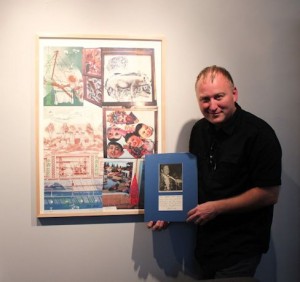 Director of Exhibitions and Collections at the Bob Rauschenberg Gallery at Florida Southwestern State College, Jade Dellinger, was John Davis’ guest on Gulf Coast Live today at 1:00 p.m. Davis questioned Dellinger about an exhibition featuring the work of world renowned artist Robert Rauschenberg that is coming to Southwest Florida. Titled “Rauschenberg: China/America Mix,” the runs opens on Bob Rauschenberg’s birthday on October 22 and runs through December 17.
Director of Exhibitions and Collections at the Bob Rauschenberg Gallery at Florida Southwestern State College, Jade Dellinger, was John Davis’ guest on Gulf Coast Live today at 1:00 p.m. Davis questioned Dellinger about an exhibition featuring the work of world renowned artist Robert Rauschenberg that is coming to Southwest Florida. Titled “Rauschenberg: China/America Mix,” the runs opens on Bob Rauschenberg’s birthday on October 22 and runs through December 17.
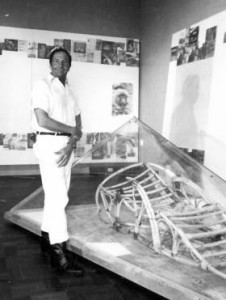 During the broadcast, Dellinger revealed that the Bob Rauschenberg Gallery at Florida SouthWestern State College had to be reconfigured and rearranged in order to accommodate the work included in the exhibition, which includes Chinese Summerhall, a 100-foot long color photograph that Rauschenberg shot while working in China. Rauschenberg: China/America Mix is the 16th solo show of Rauschenberg’s work at the gallery that bears his name, but the show marks the first solo exhibition of the artist’s work since his memorial at the gallery in 2008. Pieces selected for the exhibition highlight Rauschenberg’s fascination with China and the lasting influence the late artist’s work continues to have in inspiring art in China.
During the broadcast, Dellinger revealed that the Bob Rauschenberg Gallery at Florida SouthWestern State College had to be reconfigured and rearranged in order to accommodate the work included in the exhibition, which includes Chinese Summerhall, a 100-foot long color photograph that Rauschenberg shot while working in China. Rauschenberg: China/America Mix is the 16th solo show of Rauschenberg’s work at the gallery that bears his name, but the show marks the first solo exhibition of the artist’s work since his memorial at the gallery in 2008. Pieces selected for the exhibition highlight Rauschenberg’s fascination with China and the lasting influence the late artist’s work continues to have in inspiring art in China.
To listen to the broadcast (which has a running time of 31.03 minutes), please click here.
________________________________________________________________________________________
‘RAUSCHENBERG: China/America Mix’ first solo show of artist’s work at Rauschenberg Gallery since 2008 memorial (10-04-14)
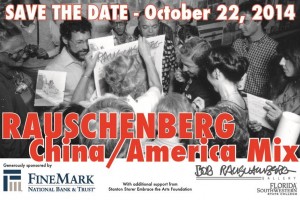 Florida SouthWestern State College and lead sponsor FineMark National Bank & Trust have announced the first solo exhibition of Bob Rauschenberg’s work at the Bob Rauschenberg Gallery since his memorial in 2008. RAUSCHENBERG: China/America Mix will be the artist’s sixteenth one-man show at the College since the Gallery was founded in 1979.
Florida SouthWestern State College and lead sponsor FineMark National Bank & Trust have announced the first solo exhibition of Bob Rauschenberg’s work at the Bob Rauschenberg Gallery since his memorial in 2008. RAUSCHENBERG: China/America Mix will be the artist’s sixteenth one-man show at the College since the Gallery was founded in 1979.
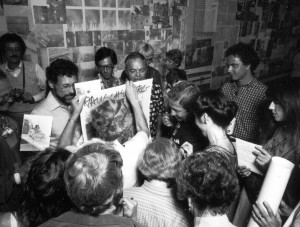 RAUSCHENBERG: China/America Mix also celebrates the 10-year anniversary of the Gallery’s renaming and dedication in the artist’s honor, and will include the first installation in more than a decade of his monumental 100-foot-long 1984 photograph, Chinese Summerhall.
RAUSCHENBERG: China/America Mix also celebrates the 10-year anniversary of the Gallery’s renaming and dedication in the artist’s honor, and will include the first installation in more than a decade of his monumental 100-foot-long 1984 photograph, Chinese Summerhall.
Widely-acknowledged as one of the most important artists of the 20th Century, 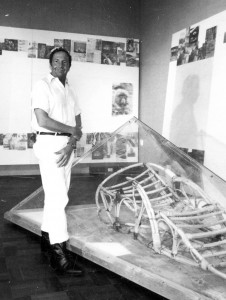 Rauschenberg is credited with pioneering the transition from European modernism to American pop art and was a highly popular Lee County resident for nearly four decades. His effect still looms large around the globe, but nowhere is this more evident than in China.
Rauschenberg is credited with pioneering the transition from European modernism to American pop art and was a highly popular Lee County resident for nearly four decades. His effect still looms large around the globe, but nowhere is this more evident than in China.
Inspired by his 1982 visit to Jing Xian and his work at the ancient Xuan Paper Mill on his 7 [Chinese] Characters collages (included in this exhibition), Rauschenberg returned to China in 1985 to mount his Rauschenberg Overseas Culture Interchange (ROCI) exhibition at the National Gallery in Beijing. Open to the public for less than three weeks, Rauschenberg’s ROCI/China show 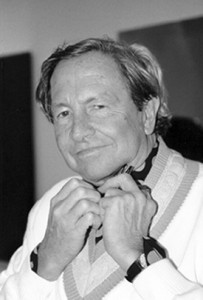 attracted more than 300,000 visitors and is still considered a seminal cultural event. To this day, the most recognized Chinese artists acknowledge his great influence and broader impact in describing art in China “before… and after Rauschenberg.”
attracted more than 300,000 visitors and is still considered a seminal cultural event. To this day, the most recognized Chinese artists acknowledge his great influence and broader impact in describing art in China “before… and after Rauschenberg.”
As the artist once noted, “ROCI [was] an attempt to create universal art, imbued with cultures of various peoples, in order to contribute to the cause of peace.” In China in particular, “while photographing the environs, a sense of China unfolded in the viewfinder of Rauschenberg’s Hasselblad,” Dr. Donald Saff observed. “The enthusiasm of his working methodology was his diplomacy and his art was magic for the people’s spirit.”
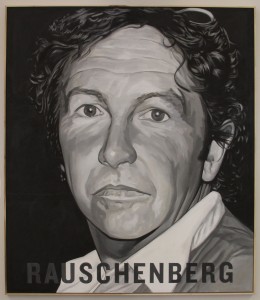 The RAUSCHENBERG: China/America Mix exhibition will open to the public from 7-9 p.m. on Bob Rauschenberg’s October 22nd birthday with musical performances by longtime friends Dickie Landry, Kat Epple and Sonic Combine. A pre-opening lecture on “Rauschenberg in China” will be presented from 6-7 p.m. by distinguished guest Dr. Donald Saff, who not only served as Founder of USF’s Graphicstudio, but as Artistic Director of Rauschenberg Overseas Culture Interchange/ROCI.
The RAUSCHENBERG: China/America Mix exhibition will open to the public from 7-9 p.m. on Bob Rauschenberg’s October 22nd birthday with musical performances by longtime friends Dickie Landry, Kat Epple and Sonic Combine. A pre-opening lecture on “Rauschenberg in China” will be presented from 6-7 p.m. by distinguished guest Dr. Donald Saff, who not only served as Founder of USF’s Graphicstudio, but as Artistic Director of Rauschenberg Overseas Culture Interchange/ROCI.
The Bob Rauschenberg Gallery was founded as The Gallery 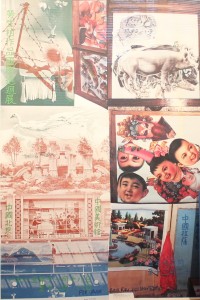 of Fine Art in 1979 on the Lee County campus of Florida SouthWestern State College/FSW (then Edison Community College). On June 4, 2004 the Gallery of Fine Art was renamed the Bob Rauschenberg Gallery to honor and commemorate its long association and friendship with the artist. Over the three plus decades prior to his death, the Gallery worked closely with Rauschenberg to present world premiere exhibitions including multiple installations of the ¼ Mile or Two Furlong Piece. The artist insisted on naming the space the Bob Rauschenberg Gallery (versus the “Robert Rauschenberg Gallery”) as it was consistent with the intimate, informal relationship he maintained with both our local Southwest Florida community and FSW.
of Fine Art in 1979 on the Lee County campus of Florida SouthWestern State College/FSW (then Edison Community College). On June 4, 2004 the Gallery of Fine Art was renamed the Bob Rauschenberg Gallery to honor and commemorate its long association and friendship with the artist. Over the three plus decades prior to his death, the Gallery worked closely with Rauschenberg to present world premiere exhibitions including multiple installations of the ¼ Mile or Two Furlong Piece. The artist insisted on naming the space the Bob Rauschenberg Gallery (versus the “Robert Rauschenberg Gallery”) as it was consistent with the intimate, informal relationship he maintained with both our local Southwest Florida community and FSW.
__________________________________________________________________
‘Rauschenberg: China/America Mix’ exhibit re-examines legacy of artist’s ROCI project and China visit (09-30-14)
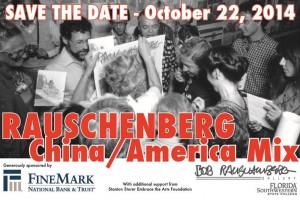 In celebration of the 10-year anniversary of the renaming of the Gallery of Fine Art at Florida SouthWestern State College (formerly Edison State College), the Bob Rauschenberg Gallery’s Fall programming will focus exclusively on the enduring legacy and profound global impact of its namesake artist Bob Rauschenberg. From October 22 through December 17, the Bob Rauschenberg Gallery will premiere RAUSCHENBERG: China/America Mix – the first solo exhibition of the artist’s work at the Gallery since his death in 2008. Work in the show relates back and examines the aftermath of the artist’s visits to China during his ROCI visits.
In celebration of the 10-year anniversary of the renaming of the Gallery of Fine Art at Florida SouthWestern State College (formerly Edison State College), the Bob Rauschenberg Gallery’s Fall programming will focus exclusively on the enduring legacy and profound global impact of its namesake artist Bob Rauschenberg. From October 22 through December 17, the Bob Rauschenberg Gallery will premiere RAUSCHENBERG: China/America Mix – the first solo exhibition of the artist’s work at the Gallery since his death in 2008. Work in the show relates back and examines the aftermath of the artist’s visits to China during his ROCI visits.
ROCI is an acronym for Rauschenberg Overseas Cultural Interchange. On an egalitarian plane, Rauschenberg conceived of ROCI as a means of forging communication with other nations through the language of art by providing carefully-selected venues where artists, sculptors, poets and authors from around the world could meet and exchange creative ideas in the spirit of collaboration.
Rauschenberg was all about collaboration long before he launched ROCI in 1984. “From his joint efforts in the late 1940’s with his former wife, Susan Weil, to multimedia performance art with Merce Cunningham and John Cage in the 1960’s, to suites of prints and sculptures in studios at Universal Limited Art Editions on Long Island, Gemeni G.E.L. in Los Angeles and GraficStudio in Tampa, Fla., he has always worked closely with others,” wrote art critic Roberta Smith in a 1991 review. “In his own working compound in Captiva, Fla., he is surrounded by young artist-assistants. Even his art ‘’collaborates.’’ He mixes media, objects and images, causing them to relate to each other in a new way.”
“To communicate is the goal,” Bob once summarized, but his overarching aim was clearly to replace people’s preconceptions and misconceptions about each other with a vision of common humanity – especially in such insular countries as China, Chile, Cuba, East Germany, Malaysia and Tibet.
“He was trying to introduce the world to itself,” Don Saff observed. Saff would know. The distinguished USF Professor Emeritus not only served as ROCI’s artistic director and organized the 1991 ROCI exhibition at the National Gallery (which served as the Interchange’s only U.S. venue), Saff helped produce Rauschenberg’s mixed media editions for the ROCI project as the founder and director of GraphicStudio.
Here’s the way it worked. With an advance staff, Rauschenberg would visit a host country and make art using local materials, ancient techniques and the special skills of local artisans. After producing anywhere from dozens to as many as 230 pieces (as in the case of Mexico), Rauschenberg would then stage a major exhibition at a museum in their country of origin. He would then take some or all of those artworks to the next destination on the ROCI tour, thereby giving artists and audiences in different countries glimpses of themselves and other nations as seen through the prism of Rauschenberg’s unerring eyes.
Each R.O.C.I. exhibition was accompanied by a catalogue written by leading poets, writers and journalists of that country, such as the writers Octavio Paz in Mexico and Jose Donoso in Chile. In each country, Rauschenberg left behind as a gift to the people of that nation a work of art he made there. Also integral to each R.O.C.I. exhibition were hundreds of black-and-white photographs, parts of which became silk-screened images in his paintings. They were typically accompanied by video verite (a term that Saff coined), continuously-running color videotapes on 10 to 15 video monitors providing scenes and sounds of the countries as seen through Rauschenberg’s lens.
Rauschenberg financed the entire venture. ”My pockets are empty,” he told a Tokyo audience, not entirely in jest. ”But to be government-sponsored would defeat the idea of the project. It has to be from people to people. We want to communicate our human kinship. I trust art to do that. Certainly politics isn’t doing a very good job.”
ROCI’s logo was the Oriental symbol of a turtle carrying the world on its back. (Rocky was also the name RR gave his 27-year-old pet turtle, but that’s another story.)
“At once altruistic and self-aggrandizing, modest and overbearing, ROCI has endured extraordinarily poor word-of-mouth within the art world for several years, especially after some of its early results – handmade paper collages produced in China in the world’s oldest paper mill – were exhibited in New York City in 1984,” wrote critic Roberta Smith in 1991. But with 30 years of hindsight, it is now manifest that what Robert Rauschenberg did through ROCI had a ripple effect worldwide.
“As I’ve travelled, I’ve talked to artists and they tell me how impactful Rauschenberg’s visit and exhibition was,” states Bob Rauschenberg Gallery Director Jade Dellinger. “And the ROCI exhibition in Beijing was the biggest blockbuster exhibition in China’s history, seen by hundreds of thousands of people [70,000 in the first day alone]. They were starving for information about what was happening in the West but had no way of being able to find out. But Rauschenberg being apolitical was able to set the information ban and restrictions aside.”
And it is to set the record straight and clarify the legacy Rauschenberg created through ROCI that Dellinger now brings RAUSCHENBERG: China/America mix to the gallery that bears the artist’s iconic name
__________________________________________________________________
Rauschenberg: China/America Mix comes to Bob Rauschenberg Gallery October 22
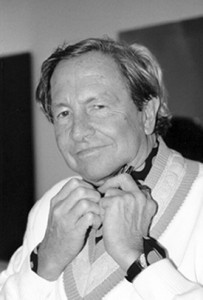 In celebration of the 10-year anniversary of the renaming of the Gallery of Fine Art at Florida SouthWestern State College (formerly Edison State College), the Bob Rauschenberg Gallery’s Fall programming will focus exclusively on the enduring legacy and profound global impact of its namesake artist Bob Rauschenberg. From October 22 through December 17, the Bob Rauschenberg Gallery will premiere RAUSCHENBERG: China/America Mix – the first solo exhibition of the artist’s work at the Gallery since his death in 2008.
In celebration of the 10-year anniversary of the renaming of the Gallery of Fine Art at Florida SouthWestern State College (formerly Edison State College), the Bob Rauschenberg Gallery’s Fall programming will focus exclusively on the enduring legacy and profound global impact of its namesake artist Bob Rauschenberg. From October 22 through December 17, the Bob Rauschenberg Gallery will premiere RAUSCHENBERG: China/America Mix – the first solo exhibition of the artist’s work at the Gallery since his death in 2008.
In 1982, Robert Rauschenberg visited Jing Xian, China. While there, he spent a substantial portion of his time working at the ancient Xuan Paper Mill and taking photographs documenting his trip. The resulting 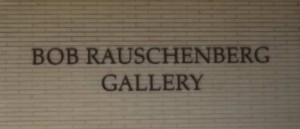 prints and images prompted Rauschenberg to take his R.O.C.I. exhibition to China three years later in 1985.
prints and images prompted Rauschenberg to take his R.O.C.I. exhibition to China three years later in 1985.
In so doing, Rauschenberg became the first Western contemporary artist to personally exhibit 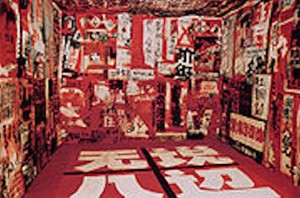 in the People’s Republic of China. The act of showcasing the Rauschenberg Overseas Cultural Initiative there truly marked a turning point in the evolution of modern Chinese art from Soviet-inspired socialist realism to more avant-garde modes of expression. While the scope and magnitude of the influence the 1985 exhibition had on the Chinese avant-garde, most art historians
in the People’s Republic of China. The act of showcasing the Rauschenberg Overseas Cultural Initiative there truly marked a turning point in the evolution of modern Chinese art from Soviet-inspired socialist realism to more avant-garde modes of expression. While the scope and magnitude of the influence the 1985 exhibition had on the Chinese avant-garde, most art historians 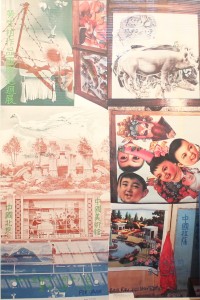 agree that without this prominent show some of China’s most dynamic works of contemporary art would never have been created.
agree that without this prominent show some of China’s most dynamic works of contemporary art would never have been created.
The ROCI exhibition at the China Art Gallery was only open from November 18 to December 8, 1985. More than 30,000 attended that first day, with in excess of 300,000 individuals, including artists from around the nation, turning out for the show during its three-week run. After the 1985 exhibition, Rauschenberg delivered a well-received lecture at the Central Academy of Graphic Art in Beijing and met with artists from Wuming huahui, the enigmatic, radical Anonymous Painting Group.
 “The exhibition halls were crowded with people who felt refreshed by a totally new form of art that they did not quite yet understand,” author Zhang Zhaohui later recalled. “It served to excite young Chinese artists’ enthusiasm to learn from him, and the show proved a stimulant to the nascent avant-garde movement. Overnight, a number of Chinese artists began producing ‘ready-mades’ and installations, and hundreds of avant-garde art groups and experimental art exhibitions appeared.”
“The exhibition halls were crowded with people who felt refreshed by a totally new form of art that they did not quite yet understand,” author Zhang Zhaohui later recalled. “It served to excite young Chinese artists’ enthusiasm to learn from him, and the show proved a stimulant to the nascent avant-garde movement. Overnight, a number of Chinese artists began producing ‘ready-mades’ and installations, and hundreds of avant-garde art groups and experimental art exhibitions appeared.”
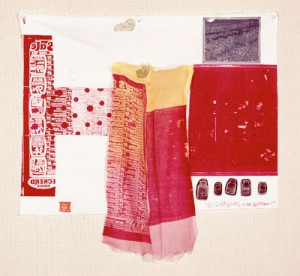 Rauschenberg’s use of borrowed imagery and objects in his mixed media compositions and combines was a natural fit for the Chinese, who have a long history of venerating appropriation in their works of art. “After the rapid economic growth and sudden influx of Western consumer products into China during the early 1990s, the appropriation of everyday consumer goods for artistic purposes became a particularly relevant way for many Chinese artists to express themselves
Rauschenberg’s use of borrowed imagery and objects in his mixed media compositions and combines was a natural fit for the Chinese, who have a long history of venerating appropriation in their works of art. “After the rapid economic growth and sudden influx of Western consumer products into China during the early 1990s, the appropriation of everyday consumer goods for artistic purposes became a particularly relevant way for many Chinese artists to express themselves 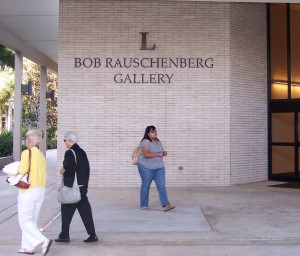 as seen in works of Political Pop and Cynical Realism,” notes author Mary Lynn Kotz in her tome Rauschenberg Himself (Harry N. Abrams, publisher, May 3, 1987). “Artists such as Wang Guangyi, Li Bangyao, Yang Guoxin, Fang Shaohua, Yuan Xiaofang, Li Shan, Yu Youhan, and Liu Dahong began using formal vocabularies influenced by American Pop artists such as Robert Rauschenberg and Andy Warhol. However, allusions to works of Social Realism, relevant to
as seen in works of Political Pop and Cynical Realism,” notes author Mary Lynn Kotz in her tome Rauschenberg Himself (Harry N. Abrams, publisher, May 3, 1987). “Artists such as Wang Guangyi, Li Bangyao, Yang Guoxin, Fang Shaohua, Yuan Xiaofang, Li Shan, Yu Youhan, and Liu Dahong began using formal vocabularies influenced by American Pop artists such as Robert Rauschenberg and Andy Warhol. However, allusions to works of Social Realism, relevant to 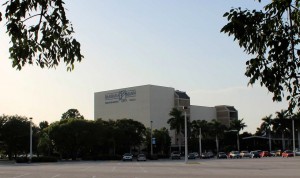 Chinese society during and after the Cultural Revolution, were also referenced in both these movements.”
Chinese society during and after the Cultural Revolution, were also referenced in both these movements.”
The Bob Rauschenberg Gallery was founded as The Gallery of Fine Art in 1979 on the Lee County campus of Florida SouthWestern State 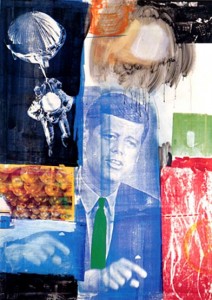 College/FSW (then Edison Community College). On June 4, 2004, the Gallery of Fine Art was renamed the Bob Rauschenberg Gallery, to honor and commemorate our long time association and friendship with the artist. Over more than three decades until his death, the Gallery worked closely with Rauschenberg to present world premiere exhibitions including multiple installations of the ¼ Mile or Two Furlong Piece. The artist insisted on naming the space the Bob Rauschenberg Gallery (versus the “Robert Rauschenberg Gallery”) as it was consistent with the intimate, informal relationship he maintained with both our local Southwest Florida community and FSW. RAUSCHENBERG: China/America Mix opens October 22.
College/FSW (then Edison Community College). On June 4, 2004, the Gallery of Fine Art was renamed the Bob Rauschenberg Gallery, to honor and commemorate our long time association and friendship with the artist. Over more than three decades until his death, the Gallery worked closely with Rauschenberg to present world premiere exhibitions including multiple installations of the ¼ Mile or Two Furlong Piece. The artist insisted on naming the space the Bob Rauschenberg Gallery (versus the “Robert Rauschenberg Gallery”) as it was consistent with the intimate, informal relationship he maintained with both our local Southwest Florida community and FSW. RAUSCHENBERG: China/America Mix opens October 22.














 Tom Hall is both an amateur artist and aspiring novelist who writes art quest thrillers. He is in the final stages of completing his debut novel titled "Art Detective," a story that fictionalizes the discovery of the fabled billion-dollar Impressionist collection of Parisian art dealer Josse Bernheim-Jeune, thought by many to have perished during World War II when the collection's hiding place, Castle de Rastignac in southern France, was destroyed by the Wehrmacht in reprisal for attacks made by members of the Resistance operating in the area. A former tax attorney, Tom holds a bachelor's degree as well as both a juris doctorate and masters of laws in taxation from the University of Florida. Tom lives in Estero, Florida with his fiancee, Connie, and their four cats.
Tom Hall is both an amateur artist and aspiring novelist who writes art quest thrillers. He is in the final stages of completing his debut novel titled "Art Detective," a story that fictionalizes the discovery of the fabled billion-dollar Impressionist collection of Parisian art dealer Josse Bernheim-Jeune, thought by many to have perished during World War II when the collection's hiding place, Castle de Rastignac in southern France, was destroyed by the Wehrmacht in reprisal for attacks made by members of the Resistance operating in the area. A former tax attorney, Tom holds a bachelor's degree as well as both a juris doctorate and masters of laws in taxation from the University of Florida. Tom lives in Estero, Florida with his fiancee, Connie, and their four cats.